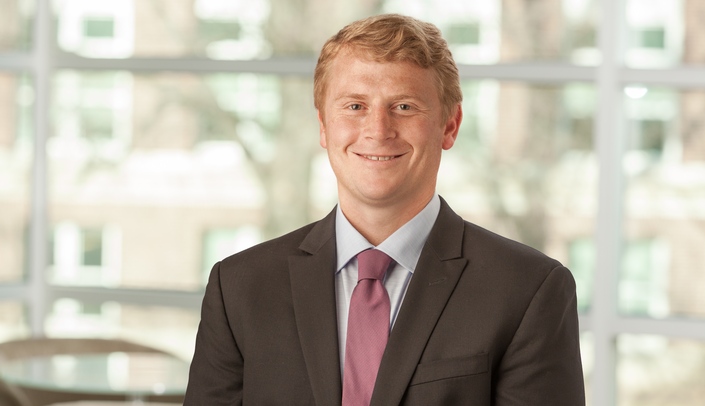Picture this: It’s 2008 in New York City. Nick Heiser, M.D., opens his eyes to discover someone in a light blue Metro Transit Authority shirt is gently shaking his shoulder. He’s on a subway car in Coney Island, about 30 stops past his intended destination. He’d fallen asleep. Again. He had been so tired after a long shift as an internal medicine intern at Queens Hospital Center, that he couldn’t manage to stay awake through the three stops between the hospital and his apartment.
"That intern year before residency was where I truly became a physician," said Dr. Heiser, who is now an assistant professor in the Department of Anesthesiology. "It was a very busy county hospital, and I worked really hard every day. At the end of the year, I left tested and confident in my ability to be a good physician."
After his intern year, Dr. Heiser joined New York University’s anesthesiology residency program, working largely in Bellevue Hospital—Manhattan’s only level-one trauma center and the oldest public hospital in the United States. A safety net hospital, Bellevue will provide healthcare regardless of ability to pay. More than 80 percent of its patients are considered medically underserved.
"Every call shift, you were in it," Dr. Heiser said. "It wasn’t uncommon to have patients come in with severed legs from subway accidents, people falling off buildings, or gunshot victims all in the same shift. We treated New Yorkers from all walks of life. You could really say you had seen it all there. You’d walk out in the morning after a call shift and say, ‘What just happened?’"
It was during his NYU residency that Dr. Heiser honed his skills in regional anesthesia—even earning chief resident in his final year of the program. Many of his mentors at NYU were leading physicians in the field of anesthesia. He joined NYU’s faculty following residency, spending much of his time working in regional anesthesia and pain management at the NYU Langone Orthopedic Hospital after Hurricane Sandy flooded NYU’s flagship hospitals, Bellevue and NYU Langone in 2012.
But, after two years, home was calling. He had come to New York City not knowing a single soul, and left with a wife, Rachel, and many life-long friends. The couple moved to Dr. Heiser’s home state of Nebraska where he became a faculty anesthesiologist at his medical school alma mater, UNMC.
He returned to the same facilities where, years earlier, Barbara Hurlbert, M.D., contributed to his decision to pursue anesthesiology over orthopedic surgery. He had once sat in an auditorium packed with medical students and listened to Dr. Hurlbert’s recounting of a harrowing case, outlining how an anesthesiologist can be at the center of a life and death scenario.
"It blew my mind," Dr. Heiser said. "Her story sounded exactly like what happened to my dad."
At age 8, Dr. Heiser was boogie boarding with his dad and brother on vacation in Hawaii. His dad was slammed by a big wave that broke his neck, rendering him unconscious and unable to swim. The boys acted quickly, flagging down a jogger on the beach who pulled their father from the ocean and performed CPR until paramedics arrived.
The traumatic event transformed their father and orthopedic surgeon, Tom Heiser, M.D., from doctor to patient. He underwent surgeries and extensive rehabilitation, eventually regaining enough upper body motion to operate a motorized wheelchair. After eight months of persistence, Dr. Tom Heiser returned to his practice, diagnosing and treating patients. Unfortunately, he could no longer perform surgery. The young Dr. Heiser grew up watching his father become transformed by medicine, both as a provider and a patient.
"As a kid, I really saw what the power of a medical education can do for you from many perspectives," said Dr. Heiser. "Despite his accident, my dad regained his health and worked a regular job. Even though his physical abilities were taken away, he can still think his way through a problem and make a medical diagnosis."
Dr. Heiser is happy he listened back in medical school when Dr. Hurlbert proclaimed that anesthesiologists have unique opportunities to turn around a coding patient. Only a few months in to returning as a faculty anesthesiologist to the university where he, his father and grandfather all graduated medical school, Dr. Heiser was already telling people he hoped it was the last job he ever has.
He currently holds many roles within the department that focus on education and pain medicine. He serves on the department education leadership team both as an associate residency program director, and the RAAPM fellowship director. Clinically, Dr. Heiser spends the majority of his time alongside orthopedic surgeons as director of anesthesia at the Fritch Surgery Center in the Laurtizen Outpatient Center. He is a member of several administrative committees, and was recently elected a member of the UNMC faculty senate.
During the ongoing COVID-19 pandemic, Dr. Heiser has frequently checked in with his loved ones in the New York City area. Many are fellow physicians who Dr. Heiser worked with during his training and employment at NYU. They are now on the front lines, working long days and managing patients in the ICU. Additionally, most of Dr. Heiser’s in-laws live in the area, including Rachel’s 94-year-old grandmother.
"It really is worse than I think any of us could imagine," Dr. Heiser said. "They’re a tough lot, however, and have been through all kinds of trying times from 9/11 to Hurricane Sandy and on and on."
In his free time, Dr. Heiser enjoys spending time with his wife and children, Henry, 4, and Mikaela, 1. The family often returns to New York City to visit loved ones, and NOT fall asleep on the subway.
Doctor’s Day Spotlight: Nick Heiser, M.D.
- Written by Danielle Beebe
- Published Mar 30, 2020
